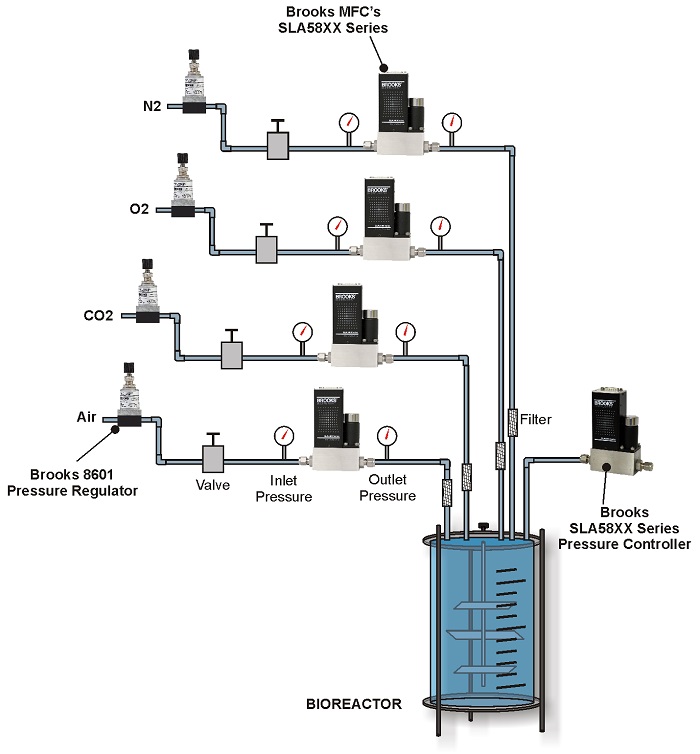Bioreactors come in a variety of shapes and sizes from small glass reactors for research applications to large stainless steel reactors for production. Measuring and controlling dissolved oxygen and pH is a critical part of the biotech process, and specifying the right process conditions when ordering the mass flow controllers is important for optimal process control.
Mass flow controllers (MFCs) have a flow sensor, integral control valve and on-board PID control electronics. The MFCs are sized, calibrated and tuned for the application based on the gas, flow rate and pressure conditions. It is important to specify the actual inlet and outlet pressure conditions that the MFC will “see”. This requires some attention to pressure drops, back pressure and pressure regulator “droop”. If the differential pressure is lower or different than specified, the device may not be able to achieve full flow and/or the valve tuning may not be optimized.
System Pressure Drop
When specifying the inlet pressure to the device, it’s important to consider any pressure drop between the pressure regulator and the MFC. Any piping, elbows, valves and fittings will cause pressure drop which results in a lower pressure at the inlet of the MFC versus what comes out of the regulator. Any pressure drop in the line should be taken into consideration to be sure you are specifying the actual pressure at the inlet of the MFC, not the pressure at the outlet of the regulator.
 Bioreactor Gas Delivery System
Bioreactor Gas Delivery System
Back Pressure
The back pressure on the MFC must also be specified. Back pressure is often specified as atmospheric pressure, but this may not be accurate. The bioreactor may be close to atmospheric pressure but there is likely some small positive pressure in the reactor. The outlet of the MFC feeds the bioreactor and typically has a filter in between that creates some back pressure. All of this leads to a non-atmospheric back pressure on the MFC, typically 2 or 3 PSIG.
Pressure Regulator Droop
Another consideration is the inlet pressure regulator. Biotech gas delivery systems typically use a pressure regulator set at 30 PSIG, give or take 5 PSI. Depending on the flow rate and quality of the pressure regulator, when the MFC is given a set point and starts controlling flow, the pressure from the regulator may drop by 5-10 PSI. This is called pressure regulator “droop”. If there is droop, the inlet pressure at the MFC may be less than expected resulting in an improperly sized and/or tuned control valve. Using a high-quality regulator can help to avoid this issue.
Understanding the actual real-time pressure conditions and communicating that information during the specifying and order process will ensure that the mass flow controller is properly sized and tuned for the application. Brooks Instrument has a full range of mass flow controllers to satisfy the many types of bioreactors. In fact, part of our long history serving this market is the result of optimizing the performance of our MFCs by duplicating the customer’s specified conditions during device calibration and valve tuning. Our goal at Brooks is that your MFCs function at peak performance in your bioreactor process!
Component datasource missing. Select a datasource for this component.